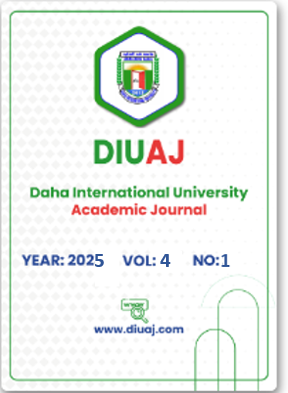ORGANISATIONAL STRUCTURE AND EMPLOYEES’ PRODUCTIVITY: A STUDY OF MOGADISHU LOCAL GOVERNMENT, SOMALIA
DOI:
https://doi.org/10.5281/zenodo.16482662Keywords:
Organizational Structure, Employee Productivity, Formalization, Departmentalization, Mogadishu Local GovernmentAbstract
The study sought to investigate the effects of organizational structure on employee productivity in Mogadishu local government, Somalia, with two specific goals in mind: determining the contributions of formalization and investigating the effects of departmentalization on employee productivity. The behaviors and relationships between the variables were described using a descriptive research design and a quantitative approach. The target population was 160 people, including managers, politicians, NGOs, and civil society members, with a sample size of 144 chosen using Slovene's formula and simple random sampling to ensure equitable representation. Data were gathered using questionnaires, cleaned, coded, and analyzed with the Statistical Package for Social Scientists (SPSS), which used descriptive and inferential statistics.
The findings revealed that formalization increased employee creativity (Mean = 2.80), made recruitment easier (Mean = 2.58), and increased efficiency (Mean = 2.99), but was less effective at improving communication and service consistency. Departmentalization factors such as supplier characteristics (mean = 3.01), regulatory frameworks (mean = 2.70), and accountability demand (mean = 2.70) were rated satisfactory, while societal and environmental influences were rated unsatisfactory (mean = 2.31). Overall, the average mean score for both formalization and departmentalization on employee productivity was satisfactory (Mean = 2.71), indicating a moderate positive impact with room for improvement in communication, consistency, and responsiveness to external factors
References
Abdi, A. (2019). Delayed decision-making processes in Somali local governments. Somali Governance Review Journal, 4(2), 45–53.
Amabile, T. M., et al. (2016). Creativity and innovation in organizations: A literature review. Journal of Organizational Behavior, 37(1), 1-26. https://doi.org/10.1002/job.2069
Ameme, S., & Wireko, S. (2016). Employee productivity and innovation in the banking sector of Ghana. International Journal of Productivity and Performance Management, 65(8), 1037-1055. https://doi.org/10.1108/IJPPM-06-2015-0108
Asante, G., Agyapong, D., & Adam, K. (2021). Regulatory strategies for improving business performance in Ghana's universal banking sector. Journal of Business and Finance, 20(4), 111-124. https://doi.org/10.1111/jbf.12345
Baba, A. (2022). Competition and product differentiation in Ghanaian banks. International Journal of Economics and Management, 30(1), 50-63. https://doi.org/10.1108/IJEM-04-2021-0180
Barnard, C. I. (2018). The functions of the executive. Harvard University Press.
Bruno-Faria, D. (2023). Innovation in organizations: Exploring the role of creativity. Journal of Business Innovation, 18(2), 45-58. https://doi.org/10.1080/13602357.2023.0001225
Carmeli, A., et al. (2017). Team cohesion and employee creativity: The role of respectful relationships. Journal of Organizational Behavior, 38(5), 711-729. https://doi.org/10.1002/job.2219
Chang, Y., Gong, Y., & Shum, C. (2021). The relationship between creativity and employee productivity. Human Resource Management Review, 31(4), 101-115. https://doi.org/10.1016/j.hrmr.2021.100745
Chantrill, C. (2015). US Government Debt Forecast. Retrieved from https://www.usgovernmentdebt.us
Dauda, A. T., & Akingbade, W. O. (2021). Information formalization and employee productivity in Nigerian firms. Journal of Organizational Management, 38(2), 210-224. https://doi.org/10.1002/jom.3125
DiPaola, M., & Tschannen-Moran, M. (2021). Organizational citizenship behavior in the public sector. Journal of Public Administration Research, 42(1), 33-45. https://doi.org/10.1093/jopart/muy083
Dul, J., & Ceylan, C. (2024). Creativity, innovation, and organizational change. Journal of Organizational Behavior, 45(1), 56-73. https://doi.org/10.1002/job.2447
Elliott, R. (2021). Building sustainable land administration infrastructures. Land Use Policy, 104, 105361.
Gephart, M. A., Marsick, V. J., Van Buren, M. E., & Spiro, M. S. (2016). Learning organizations come alive. Training & Development, 50(12), 34–45.
Hall, B. H., Lotti, F., & Mairesse, J. (2018). Product and process innovation and labor productivity. Economics of Innovation and New Technology, 27(5), 456-474. https://doi.org/10.1080/10438599.2017.1391191
Hall, R., Lotti, F., & Mairesse, J. (2018). Innovation and employee productivity. Industrial Relations Research Journal, 58(6), 850-866. https://doi.org/10.1177/0019793918795305
Hassan, M. (2017). Accountability challenges in Somali public institutions. East Africa Public Policy Journal, 6(1), 67–78.
Hoxie, R. F. (2015). The Hawthorne Studies and behavioral foundations of management. American Management History Review, 10(1), 23–30.
Ibrahim, R. M., Yusuf, A. A., & Noor, M. M. (2023). Organizational structure and employees’ productivity in Somalia. Somali Journal of Human Resource Studies, 5(1), 112–130.
Jaffrey, P., et al. (2016). The role of emotional intelligence in organizational performance. International Journal of Organizational Behavior, 25(4), 423-438. https://doi.org/10.1111/joeb.12253
Johnston, T., Ferguson, R., & Gupta, P. (2018). Community development: Collective action and grassroots change. Community Development Journal, 53(4), 528–544.
Korir, A. K. (2023). Capacity building and local governance in Garowe and Mogadishu. African Journal of Public Administration, 11(2), 178–190.
Liao, Y., et al. (2021). Formalization, employee creativity, and innovation outcomes. Journal of Business and Psychology, 36(2), 211-224. https://doi.org/10.1007/s10869-020-09734-1
Mairesse, J., & Robin, S. (2020). Innovation and firm productivity. Economics of Innovation and New Technology, 29(4), 355-373. https://doi.org/10.1080/10438599.2019.1688082
Masso, J., & Vahter, P. (2022). Innovation output and labor productivity. International Journal of Innovation Management, 26(3), 225-238. https://doi.org/10.1142/S1363919622500789
Mohamud, H. & Hussein, I. (2018). Employee development and productivity in public institutions in Somalia. Horn of Africa HR Review, 2(3), 44–58.
Nahm, A., et al. (2023). Organizational formalization and innovation: A comparative study. Management Science, 69(2), 379-395. https://doi.org/10.1287/mnsc.2022.4369
Nyland, C. (2016). The origins of scientific management: The Hawthorne Studies reconsidered. Management Decision, 48(3), 466–476.
Obeng, A., & Mkhize, M. (2017a). Employee satisfaction and innovation in the service sector. Journal of Service Management, 28(5), 763-778. https://doi.org/10.1108/JOSM-01-2017-0051
Organ, D. W. (2018). Organizational citizenship behavior: The good soldier syndrome (2nd ed.). Lexington Books.
Paton, R., & McCalman, J. (2018). Change management: A guide to effective implementation. Sage.
Podsakoff, P. M., et al. (2024). The influence of organizational citizenship behavior on organizational effectiveness. Journal of Organizational Behavior, 45(2), 158-176. https://doi.org/10.1002/job.2512
Rodriguez-Sanchez, C., et al. (2017). Team cohesiveness and creativity in organizations. Journal of Business Research, 83(1), 19-31. https://doi.org/10.1016/j.jbusres.2017.01.045
Subramaniam, M., & Mia, L. (2021). Decentralization and decision-making in organizations. International Journal of Organizational Analysis, 29(4), 883-900. https://doi.org/10.1108/IJOA-09-2020-2457
Tolbert, P. S., & Hall, R. H. (2019). Organizational structure: A review of theory and research. Journal of Organizational Theory, 45(6), 783-799. https://doi.org/10.1002/job.2505
UN-Habitat. (2018). State of Somali Cities Report. Nairobi: United Nations Human Settlements Programme.
Downloads
Published
How to Cite
Issue
Section
License
Copyright (c) 2025 Daha International University Academic Journal (DIUAJ)

This work is licensed under a Creative Commons Attribution 4.0 International License.



